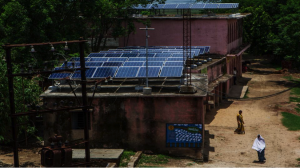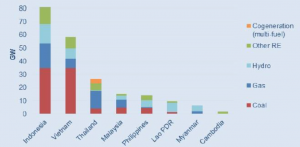While some of the developing world leapfrogged to cellular phones without ever using landlines first, it does not have a matching appetite for skipping over central station power generated by reliable traditional technologies for solar power and mini-grids. An attempt to leapfrog to mini-grids using solar power in northeastern India resulted in no takers at the true cost of the system and only a few takers when it was heavily subsidized. In Dharnai, a village in the state of Bihar near the Nepalese border, youngsters demanded the “real source of energy,” rather than “the fake solar powered” energy after a solar micro-grid was installed providing electricity for the first time in 33 years.[i] Among developing countries, including China and India, there is a long-standing recognition of the need for fossil fuels, especially coal, which is more abundant and has a competitive edge over natural gas. This is particularly true in Southeast Asia and Sub-Saharan Africa where coal reserves are plentiful.
Source: Forbes
Study on Solar Power and the Mini-Grid
Michael Greenstone, a University of Chicago economist, has researched energy economics in Bihar. The state has 100 million people living within it, but only 5 million of them are supplied with grid-connected electricity. Greenstone and his team of scholars from Yale, Harvard and the London School of Economics wanted to learn the price point residents would accept for solar power. They found that at prices that reflect the cost of supplying solar power and the mini-grid, there was almost no demand. If the government subsidized the price to where most businesses could pay for the power, the demand was only about nine percent.[ii]
The researchers wanted to know why the residents were not favorable to the solar mini-grid concept. The answer was that they wanted real electricity, i.e., central station grid-connected power that was reliable and available around the clock.
The Demand for Coal
Asia and Africa are expected to become major coal consumers. Thirty percent of the increase in the world’s energy demand from now to 2040 is expected to be from India: coal, natural gas and nuclear are largely expected to supply that energy. China’s coal-fired generation is expected to increase by as much as 19 percent by 2020.
In Southeast Asia, coal is the preferred fuel for electricity generation due to its lower cost compared to competing fuels. The region added 25 gigawatts of coal-fired capacity in the past five years, accounting for 42 percent of new generating capacity; it had 62 gigawatts of coal-fired capacity at the end of 2015. There are 29 gigawatts of coal-fired capacity under construction and most will be operational by 2020. In addition, there are over 100 gigawatts of coal-fired capacity that have either been permitted or announced. The chart below shows the expected capacity additions by technology for each Southeast Asian country between 2016 and 2025.[iii]
Generating Capacity Additions by Country and Technology (2016 to 2025)
Source: Oxford Energy
Because Sub-Saharan Africa has vast coal reserves, coal-fired electricity will be a major economically viable source of power. According to the International Energy Agency (IEA), coal consumption in Africa is expected to increase from 5 quadrillion Btu in 2012 to 7 quadrillion Btu in 2040 due to the increase in electricity demand.[iv]
Unfortunately for developing countries, global institutions and international finance bodies have adopted a hard line, promoting renewable energy over more traditional approaches including coal. For example, the World Bank restricted funding for coal plants in 2013[v], and Deutsche Bank stopped all coal financing in 2017.[vi] However, President Trump’s policy to promote clean coal technology is putting pressure on multilateral development banks such as the World Bank to rethink their stance.
The U.S. Treasury Department indicated that it will use its vote to push banks to help countries access and use fossil fuels more cleanly and efficiently. This helps developing countries and provides demand and jobs for the U.S. coal industry—part of President Trump’s “energy dominance” strategy. At the Clean Energy Ministerial Meeting in June, Energy Secretary Rick Perry noted that the United States and India are discussing plans to broaden joint research on clean coal and carbon capture technology.[vii]
Conclusion
Under the Obama Administration, wind and solar were pushed here and abroad as the fuels for generating electricity. However, despite access to solar power and micro-grids, citizens in developing countries want power that they can rely on 24 hours a day. For many of those developing countries, coal is abundant and the lowest cost fuel for electricity generation, providing reliable electricity generation 24/7. Hopefully, President Trump’s energy dominance strategy will help those people get the power that they need.
[i] Daily Mail, Bihar village rejects solar-powered micro-grid and demands ‘real’ electricity, August 6, 2014, http://www.dailymail.co.uk/indiahome/indianews/article-2717149/Bihar-village-rejects-solar-powered-micro-grid-demands-real-electricity.html
[ii] Forbes, What If We Gave The World Solar Mini-Grids, And The World Didn’t Want Them, August 3, 2017, https://www.forbes.com/sites/jeffmcmahon/2017/08/03/what-if-we-gave-the-world-solar-mini-grids-and-the-world-didnt-want-them/amp/?utm_source=Breakthrough%2BNewsletter&utm_campaign=5819024a82-Breakthrough%2BDispatches%2B8-8-2017&utm_medium=email&utm_term=0_49b872540e-5819024a82-152704733#3b48005af693
[iii] The Oxford Institute for Energy Studies, The role of coal in Southeast Asia’s power sector and implication for global and regional coal trade, December 2016, https://www.oxfordenergy.org/wpcms/wp-content/uploads/2016/12/The-role-of-coal-in-Southeast-Asias-power-sector-CL-4.pdf
[iv] Oil Price, Was Trump Right About Coal?, July 30, 2017, http://oilprice.com/Energy/Energy-General/Was-Trump-Right-About-Coal.html
[v] Reuters, World Bank to limit financing of coal-fired plants, July 16, 2013, http://www.reuters.com/article/us-worldbank-climate-coal-idUSBRE96F19U20130716
[vi] Guardian, Deutsche Bank pulls out of coal projects to meet Paris climate pledge, January 31, 2017, https://www.theguardian.com/business/2017/feb/01/deutsche-bank-pulls-out-of-coal-projects-to-meet-paris-climate-pledge
[vii] Hindustan Times, US keen to collaborate with India on clean coal technology, June 11, 2017, http://www.hindustantimes.com/world-news/us-keen-to-collaborate-with-india-on-clean-coal-technology/story-xmgNgDArq5gBAUXfdF5MyI.html





